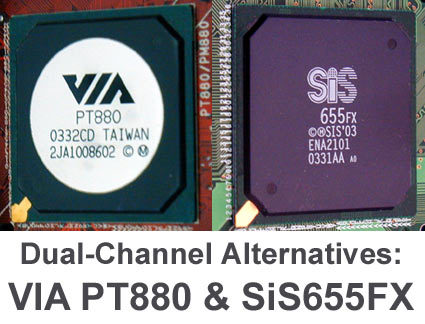Affordable Alternatives: DDR400 Dual-Channel Chipsets for the Pentium 4
Dual-Channel DDR400 At Reasonable Prices: SiS 655FX And VIA PT880
High-performance desktops differ in their type of CPU, hard drive or graphics card. However, there is one factor that has become a constant for a couple of months now: If you want maximum performance, you must make do with dual-channel DDR memory.
The reason for this is simple: There is no alternative now. While DDR memory was a radical advancement over standard SDRAM in order to boost bandwidth, the successor to DDR memory is not ready for market now. The industry had a demand for higher memory bandwidth, which finally was satisfied by the parallel usage of two 64 Bit memory channels.
While first dual-channel platforms were based on DDR266 (PC2100) memory only, DDR333 (PC2700) was quickly added by some manufacturers. Intel, however, decided to stay with Dual-DDR266 until the Pentium 4 at 800 MHz system speed was launched. Obviously, a memory clock increase to Dual-DDR333 at the cost of losing synchronous RAM operation mode raises the efforts on the hardware side without resulting in much better performance.
Intel's 865PE and 875P chipsets perfectly fit into the idea of synchronous memory, since two 200 MHz dual data rate channels (PC3200) result in an effective clock speed of 800 MHz, matching with FSB800. SiS and VIA of course support the same, but they offer additional memory clocking modes, enabling the user to run a couple of pseudo-synchronous configurations, e.g. a FSB400 processor with Dual-DDR333 memory. They are quite useful to upgrading users, since they don't need to buy new DDR memory if they already own two equal DIMMs.
Both SiS and VIA took some time, but now they can present products that technically feel up to the mark: The SiS655FX incorporates a new southbridge called SiS964. This one gives you eight USB 2.0 ports now and also offers two Serial ATA ports. VIA's PT880 chipset looks very much the same on the first look, but comes with some more features that we discuss in the corresponding section.
The most important question, however, is the following one: Do the new chipsets stick up to our expectations? Considering that both Taiwanese companies had much more time than Intel before they released a corresponding dual-channel chipset, we expect at least similar performance. The test motherboard with the VIA PT880 is an engineering sample from Soltek, while the motherboard SiS655FX came directly from SiS. The games shall begin now! Let's hope we don't need to release the lions.
Get Tom's Hardware's best news and in-depth reviews, straight to your inbox.
Current page: Dual-Channel DDR400 At Reasonable Prices: SiS 655FX And VIA PT880
Next Page Serial ATA Finally Here
Patrick Schmid was the editor-in-chief for Tom's Hardware from 2005 to 2006. He wrote numerous articles on a wide range of hardware topics, including storage, CPUs, and system builds.
